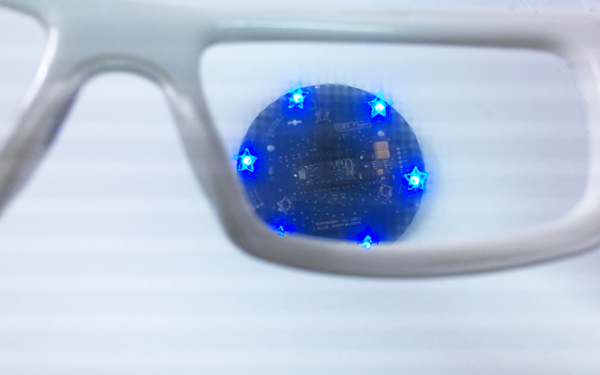What Is Light Diffraction
September 07, 2017

The Concept of Light Diffraction
Diffraction is the bending of waves around obstacles, or the spreading of waves by passing them through an aperture, or opening. Any sort of energy that travels in a wave is capable of diffraction, and the diffraction of light and sound waves produces a range of effects. Sound waves are much bigger than light waves, however, so diffraction of sound is a part of everyday life that most people today take for granted. Diffraction of light waves, on the other hand, is a lot more complex, and has a range of applications in science and technology, including the use of diffraction gratings in the creation of holograms.
HOW IT WORKS
Sound VS Light
 Imagine going into a music venue for your favorite electronic dance music (EDM) and you find yourself directly behind a building beam. You can't see the band, obviously, since the light waves in the point are obstructed. However, you have very little trouble hearing the music, because sound waves easily diffract around the pillar. Light waves diffract marginally in such a circumstance, but not enough to make a difference regarding your enjoyment of the concert. If you were to look carefully while behind the beam, you would observe the diffraction of the light waves glowing slightly as they wrap round the post.
Imagine going into a music venue for your favorite electronic dance music (EDM) and you find yourself directly behind a building beam. You can't see the band, obviously, since the light waves in the point are obstructed. However, you have very little trouble hearing the music, because sound waves easily diffract around the pillar. Light waves diffract marginally in such a circumstance, but not enough to make a difference regarding your enjoyment of the concert. If you were to look carefully while behind the beam, you would observe the diffraction of the light waves glowing slightly as they wrap round the post.
 Suppose, now, that you had neglected to get a ticket to the music festival, but a friend who worked in the concert venue organized to allow you to stand outside an open door and listen to the band. The audio quality could be far from ideal, of course, but you would still have the ability to hear the music well enough. And if you stood right in front of the door, you would have the ability to see light from inside the concert hall. But, in the event that you moved away from the door and stood with your back to the building, you'd see little light, whereas the noise would still be readily perceptible.
Suppose, now, that you had neglected to get a ticket to the music festival, but a friend who worked in the concert venue organized to allow you to stand outside an open door and listen to the band. The audio quality could be far from ideal, of course, but you would still have the ability to hear the music well enough. And if you stood right in front of the door, you would have the ability to see light from inside the concert hall. But, in the event that you moved away from the door and stood with your back to the building, you'd see little light, whereas the noise would still be readily perceptible.
Wavelength & Diffraction
The reason for the difference is that sound diffraction is more distinct than light diffraction - sound waves are much, much bigger than light waves. Sound travels by longitudinal waves, or waves where the motion of vibration is in precisely the exact same direction as the tide itself. Imagine sound like you would a target with the concentric circles continuing to radiate outward like calm water rippling after a rock is dropped in the middle.
The waves where sound is transmitted are bigger, or equal in size to, the column or the door or other opening or aperture and, hence, they pass easily through such openings or around barriers. Light waves, on the other hand, have a wavelength, typically measured in nanometers (nm), which are equivalent to one-millionth of a millimeter. Wavelengths for visible light range from 400 (violet) to 700 nm (red) - this makes it possible to fit about 5,000 of even the maximum visible-light wavelengths on the head of a pin!
Whereas differing wavelengths in light are shown as diverse colours, a change in audio wavelength suggests a change in pitch. Much like mild ocean waves, but to a much lesser extent, short-wavelength sound waves are less capable of diffracting around massive objects than are long-wavelength sound waves. As an example, the most readily audible sounds from within a concert hall would be the drums and bass; higher-pitched notes that have a shorter wavelength, say from a string instrument, aren't as likely to reach a listener.
Observing Light Diffraction
We've already seen that wavelength plays a part in diffraction, and we lightly mentioned that aperture, or the relative opening of an object, also affects diffraction. Most studies of diffraction use very tiny openings.
Light is unique in that it does not just diffract when passing through an aperture, it also diffracts around obstacles. This can be observed by looking closely at the shadow of a flagpole. At first, it seems that the shadow is "strong," but if one looks closely enough, it will become evident that, at the borders, there's a blurring from darkness to light. This "grey area" is an example of light diffraction.
Where the obstruction or aperture is large in comparison with the wave passing through or around it, there's just a little "fuzziness" in the border, as in the case of the flagpole. This same effect could be seen recently during totality of the last solar eclipse - Shadow Bands. When light passes through an aperture, the majority of the beam goes straight through without interference, with just the borders experiencing diffraction. If, however, the size of this aperture is close to that of the wavelength, the diffraction pattern will expand. Sound waves diffract at large angles through an open doorway, which, as noted, is comparable in size to a sound wave; likewise, when light is passed through extremely narrow openings, its diffraction is more noticeable.
 Early Diffraction Science
Early Diffraction Science
Sir Isaac Newton(1642-1727) is best known for his studies of gravity and motion, though he also analyzed light. With a prism, he split the colors of the visible light spectrum - this had already been done by other scientists - but it was Newton who discerned that the colours of the spectrum might be recombined to form white light again.
Newton also debated the nature of light itself and in these debates light diffraction studies played an important role. Mr. Newton's view, known as the corpuscular theory of light, was that light travels as a stream of particles. Newton's contemporary, Dutch physicist and astronomer Christiaan Huygens (1629-1695), advanced the wave theory idea that light travels by way of waves. Huygens maintained that several factors, such as the phenomena of reflection and refraction, indicate that light is a wave. Newton, on the other hand, challenged wave theorists by saying that if light were really a wave, it ought to have the ability to bend around corners - diffraction.
Francesco Grimaldi Discovers Light Diffraction
Though it didn't become widely known until a while afterwards, in 1648 - over a decade prior to the particle-wave controversy - Johannes Marcus von Kronland (1595-1667), a scientist in Bohemia (now part of the Czech Republic), discovered the diffraction of light waves. However, his findings weren't recognized until a while afterwards; nor did he give a name to the phenomenon he'd observed.
In 1660 it was Italian physicist Francesco Grimaldi (1618-1663) who conducted a diffraction experiment that gained widespread attention. Grimaldi let a ray of light to pass through two narrow apertures, one behind the other onto a blank surface. What he observed is that the band of light hitting the surface was slightly wider than it ought to be, depending on the width of the beam that entered the initial aperture. He reasoned that the beam was bent slightly outward, and gave this phenomenon the name by which it is known now: diffraction.
 FRESNEL AND FRAUNHOFER DIFFRACTION.
FRESNEL AND FRAUNHOFER DIFFRACTION.
Particle theory continued in England, Newton's homeland, but by the time of French physicist Augustin Jean Fresnel (1788-1827) came around, a growing number of scientists in the European continent had begun to accept the wave concept. Fresnel's work, which he published in 1818, served to advance this theory, and, particularly, the thought of light as a transverse wave.
 In Mémoire sur la diffraction de la lumière, Fresnel revealed that the transverse-wave model accounted for a range of phenomena, such as diffraction, reflection, refraction, interference, and polarization, or a change in the oscillation patterns of a light wave. Four years after publishing this important work, Fresnel put his theories into action and used the transverse model to make a pencil-beam of light - the same kind you would expect to beam from a light house. This prism system, whereby all of the light emitted from a source is inserted right to a flat beam, replaced the old method of mirrors used since ancient times. In the process Fresnel's work forever altered the efficacy of lighthouses saving countless lives.
In Mémoire sur la diffraction de la lumière, Fresnel revealed that the transverse-wave model accounted for a range of phenomena, such as diffraction, reflection, refraction, interference, and polarization, or a change in the oscillation patterns of a light wave. Four years after publishing this important work, Fresnel put his theories into action and used the transverse model to make a pencil-beam of light - the same kind you would expect to beam from a light house. This prism system, whereby all of the light emitted from a source is inserted right to a flat beam, replaced the old method of mirrors used since ancient times. In the process Fresnel's work forever altered the efficacy of lighthouses saving countless lives.
The expression "Fresnel diffraction" refers to a scenario where the light source or the screen is near the aperture; however there are other scenarios where the source, aperture, and scree (or at least two of those three) are widely separated. This is called Fraunhofer diffraction, after German physicist Joseph von Fraunhofer (1787-1826), who in 1814 found the lines of the solar spectrum (source) while using a prism (aperture). His work had a huge effect in the study of spectroscopy - the interaction between electromagnetic radiation and matter.
How Light Diffraction is Used in Real Life
Over time the work of Scottish physicist James Clerk Maxwell (1831-1879), German physicist Heinrich Rudolf Hertz (1857-1894), and many others affirmed that light did indeed travel in waves. And, it was Albert Einstein (1879-1955) who revealed that light behaves both as a wave and, in certain conditions, as a particle.
In 1912, a few years after Einstein published his findings, German physicist Max Theodor Felix von Laue (1879-1960) created a diffraction grating. Using crystals in his grating, he demonstrated that x-rays are a part of the electromagnetic spectrum. Laue's work, which earned him the Nobel Prize in physics in 1914, also made it feasible to gauge the distance of x rays, and, finally, given a means for studying the atomic structure of crystals and polymers.
Studies in diffraction progressed more during the early twentieth century. In 1926, English physicist J. D. Bernal (1901-1971) developed the Bernal chart, allowing scientists to deduce the crystal structure of a solid by analyzing photos of x-ray diffraction patterns. A decade later, Dutch-American physical chemist Peter Joseph William Debye (1884-1966) won the Nobel Prize in Chemistry for his research in the diffraction of x rays and electrons in gases, which advanced understanding of molecular structure.
 In 1937, a year after Debye's Nobel, American physicist Clinton Joseph Davisson (1881-1958) and English physicist George Paget Thomson (1892-1975) won the Prize in Physics for their discovery that crystals can diffract electrons.
In 1937, a year after Debye's Nobel, American physicist Clinton Joseph Davisson (1881-1958) and English physicist George Paget Thomson (1892-1975) won the Prize in Physics for their discovery that crystals can diffract electrons.
Additionally, in 1937, English physicist William Thomas Astbury (1898-1961) used x-ray diffraction to detect the earliest information regarding nucleic acid, which resulted in improvements in the analysis of DNA (deoxyribonucleic acid), the building-blocks of human genetics. In 1952, English biophysicist Maurice Hugh Frederick Wilkins (1916-) and molecular biologist Rosalind Elsie Franklin (1920-1958) used x-ray diffraction to picture DNA. Their work directly affected a breakthrough event that followed a year later: the discovery of this double-helix or double-spiral version of DNA by American molecular biologists James D. Watson (1928-) and Francis Crick (1916-). Now, studies in DNA are in the frontiers of research in biology and related fields.
Diffraction Grating
Much of the work described in the previous paragraphs made use of a diffraction grating, first developed in the 1870s by American physicist Henry Augustus Rowland (1848-1901). A diffraction grating is an optical device which is composed of not one but many thousands of apertures: Rowland's machine utilized a fine tipped diamond to rule glass gratings, with about 15,000 lines per in (2.2 cm). Diffraction gratings now can have as many as 100,000 apertures per inch. The apertures at a diffraction grating aren't mere holes, but extremely narrow parallel slits that change a beam of light into a spectrum.
Each opening diffracts the light beam, but since they are equally spaced and the same in diameter, the diffracted waves encounter constructive interference. This constructive interference pattern makes it feasible to look at components of this spectrum separately, thus allowing a scientist to observe characteristics which range from the arrangement of atoms and molecules to the chemical composition of stars.
 X-Ray Diffraction
X-Ray Diffraction
Since they're much higher in energy and frequency levels, x rays are much shorter wavelengths than visible light waves. Hence, for x-ray diffraction, it's essential to have gratings where lines are separated by infinitesimal distances. These distances are generally measured in units known as an angstrom, where there are 10 million into a millimeter. Angstroms are used to measure molecules, and, indeed, the distances between lines within an x-ray diffraction grating are similar to the size of atoms.
When x ray radiation is absorbed by the crystal in the form of x rays, atoms in the crystal diffract the beams. One of the aspects of a crystal clear is that its atoms are equally spaced, and, due to this, it's possible to detect the location and distance between atoms by analyzing x-ray diffraction patterns. Bragg's law, named after the father-andson team of English physicists William Henry Bragg (1862-1942) and William Lawrence Bragg (1890-1971), describes x-ray diffraction patterns in crystals.
Though much about x-ray diffraction and crystallography seems rather subjective, its application in areas like DNA research suggests that it has numerous applications for enhancing human life. The elder Bragg expressed this reality in 1915, the year he and his son received the Nobel Prize in physics, stating that "We are now able to look ten thousand times deeper into the structure of the matter that makes up our universe than when we had to depend on the microscope alone." Now, physicists applying x-ray diffraction use a tool called a diffractometer, which helps them compare diffraction patterns with those of known crystals, as a method of specifying the construction of new materials.
 Holograms
Holograms
The word hologram is derived from the Greek holos, "entire," and gram, "message" and is a three-dimensional (3-D) impression of an object produced through a process known as holography. Holograms take advantage of laser beams that combine at an angle, producing an interference pattern of alternating bright and dark lines. The surface of the hologram itself is a kind of diffraction grating, with alternating strips of clear and opaque material. An illuminating laser beam is diffracted at particular angles, according to Bragg's law, on the surfaces of the hologram, which makes it possible for an observer to view a three-dimensional picture.
Holograms are not to be confused with ordinary three-dimensional pictures which use only visible light. The latter are produced by a method called stereoscopy, which creates one image from 2, superimposing the images to create the impression of a picture with depth. Though stereoscopic pictures make it look like you can "step into" the image, a hologram actually enables the viewer to glimpse the picture from any angle. Therefore, stereoscopic images can be compared to looking through the plate-glass window of a shop display, whereas holograms communicate the feeling that one has really stepped into the shop window itself.
Developments in Holography
While trying to enhance the resolution of electron microscopes in 1947, Hungarian-English physicist and engineer Dennis Gabor (1900-1979) developed the notion of holography and coined the term "hologram." His work in this area was limited until the laser was introduced in 1960. By the early 1960s scientists were already using lasers to create 3-D images, and in 1971, Gabor received the Nobel Prize in physics for the discovery he had made a generation before.
 Today, holograms are used on credit cards or other identification cards as a safety measure, providing a picture read by optical scanners. Supermarket checkout scanners utilize holographic optical elements (HOEs), which can read a universal product code (UPC) from any angle. The use of holograms in daily life and scientific research is very likely to grow as scientists find new programs: for example, holographic images will help the design of everything from bridges to cars.
Today, holograms are used on credit cards or other identification cards as a safety measure, providing a picture read by optical scanners. Supermarket checkout scanners utilize holographic optical elements (HOEs), which can read a universal product code (UPC) from any angle. The use of holograms in daily life and scientific research is very likely to grow as scientists find new programs: for example, holographic images will help the design of everything from bridges to cars.
Among the most fascinating areas of study within the field of holography is holographic memory. Computers use a binary code, a pattern of ones and zeroes that's translated into a digital pulse, but holographic memory could greatly expand the capabilities of computer memory systems. Unlike many images, a hologram isn't just the sum of its constituent components: the information in a holographic picture is contained in each part of the picture, meaning that a portion of the picture can be destroyed with no loss of information.
 Holographic Memory
Holographic Memory
To bring the story full-circle, the idea of holographic memory was advanced by German mathematician and philosopher Gottfried Wilhelm Leibniz (1646-1716) - a rival of Newton - together with Huygens. Although Newton is generally credited as the father of calculus, Leibniz developed his own version of calculus at roughly the same time.
As a philosopher, Leibniz apparently had quite a few thoughts viewed as odd by his contemporaries. This made him a laughing stock among factors of European intellectual society. Voltaire (François-Marie Arouet; 1694-1778), the French author and thinker, satirized him with the character Dr. Pangloss at Candide(1759). Few of Leibniz's ideas were more eccentric than that of the monad: an elementary particle of existence that reflected the whole of the universe.
In advancing the notion of a monad, Leibniz wasn't making a statement after the manner of a scientist: there wasn't any evidence that monads existed, nor was it feasible to demonstrate the prove of a monad in any scientific experiment. However, a hologram is very similar to a manifestation of Leibniz's imagined monads, and both the hologram and the monad relate to a more basic element of life: human memory. Neurological research in the late twentieth century indicated that the arrangement of memory within the human mind is holographic. Thus, for example, a patient suffering an accident affecting 90 percent of the mind experiences only a 10 percent memory loss.
Where To Learn More
- Article adapted from Encyclopedia.com
-
Barrett, Norman S. Lasers and Holograms. New York: F. Watts, 1985.
-
"Bragg's Law and Diffraction: How Waves Reveal the Atomic Structure of Crystals" (Web site). <http://www.journey.sunysb.edu/ProjectJava/Bragg/home.html> (May 6, 2001).
-
Burkig, Valerie. Photonics: The New Science of Light. Hillside, N.J.: Enslow Publishers, 1986.
-
"Diffraction of Sound" (Web site). <http://hyperphysics.phy-astr.gsu.edu/hbase/sound/diffrac.html> (May 6, 2001).
-
Gardner, Robert. Experimenting with Light. New York: F. Watts, 1991.
-
Graham, Ian. Lasers and Holograms. New York: Shooting Star Press, 1993.
-
Holoworld: Holography, Lasers, and Holograms (Web site). <http://www.holoworld.com> (May 6, 2001).
-
Proffen, T. H. and R. B. Neder. Interactive Tutorial About Diffraction (Web site). <http://www.uniwuerzburg.de/mineralogie/crystal/teaching/teaching.html> (May 6, 2001).
-
Snedden, Robert. Light and Sound. Des Plaines, IL: Heinemann Library, 1999.
-
"Wave-Like Behaviors of Light." The Physics Classroom (Web site). <http://www.glenbrook.k12.il.us/gbssci/phys/Class/light/u12l1a.html> (May 6, 2001).
KEY TERMS
APERTURE:
An opening.
DIFFRACTION:
The bending of waves around obstacles, or the spreading of waves by passing them through an aperture.
ELECTROMAGNETIC SPECTRUM:
The complete variety of electromagnetic waves on a continuous distribution from a really low variety of frequencies and energy levels, with a correspondingly long wavelength, to a very significant variety of frequencies and energy levels, with a correspondingly short wavelength. Contained on the electromagnetic spectrum are long-wave and short-wave radio; microwaves; infrared, visible, and ultraviolet light; x ray, and gamma rays.
FREQUENCY:
The amount of waves passing through a given point during the period of one second. The greater the frequency, the shorter the wavelength.
LONGITUDINAL WAVE:
A wave in which the motion of vibration is in precisely the exact same direction as the tide itself. A sound wave is a good example of a longitudinal wave.
PRISM:
A three-dimensional glassshape used for the diffusion of light rays.
PROPAGATION:
The state or act of traveling from one spot to another.RADIATION:In an overall sense, radiation may refer to anything that travels in a stream, whether that flow be composed of subatomic particles or electromagnetic waves.
REFLECTION:
A phenomenon where a light beam is returned toward its origin rather than being consumed at the port.
REFRACTION:
The bending of a lightray that happens when it passes through a dense medium, such as glass or water.
SPECTRUM:
The continuous distribution of properties in an ordered arrangement across an unbroken variety. Examples of spectra (the plural of "spectrum") comprise the colours of visible light, or the electromagnetic spectrum of that visible light is a part.
TRANSVERSE WAVE:
A wave in which the vibration or movement is perpendicular to the direction in which the wave is moving.
WAVELENGTH:
The distance between a crest and the adjoining crest, or the trough and an adjacent trough, of a wave. The shorter the wavelength, the greater the frequency.


 Imagine going into a music venue for your favorite electronic dance music (EDM) and you find yourself directly behind a building beam. You can't see the band, obviously, since the light waves in the point are obstructed. However, you have very little trouble hearing the music, because sound waves easily diffract around the pillar. Light waves diffract marginally in such a circumstance, but not enough to make a difference regarding your enjoyment of the concert. If you were to look carefully while behind the beam, you would observe the diffraction of the light waves glowing slightly as they wrap round the post.
Imagine going into a music venue for your favorite electronic dance music (EDM) and you find yourself directly behind a building beam. You can't see the band, obviously, since the light waves in the point are obstructed. However, you have very little trouble hearing the music, because sound waves easily diffract around the pillar. Light waves diffract marginally in such a circumstance, but not enough to make a difference regarding your enjoyment of the concert. If you were to look carefully while behind the beam, you would observe the diffraction of the light waves glowing slightly as they wrap round the post. Suppose, now, that you had neglected to get a ticket to the music festival, but a friend who worked in the concert venue organized to allow you to stand outside an open door and listen to the band. The audio quality could be far from ideal, of course, but you would still have the ability to hear the music well enough. And if you stood right in front of the door, you would have the ability to see light from inside the concert hall. But, in the event that you moved away from the door and stood with your back to the building, you'd see little light, whereas the noise would still be readily perceptible.
Suppose, now, that you had neglected to get a ticket to the music festival, but a friend who worked in the concert venue organized to allow you to stand outside an open door and listen to the band. The audio quality could be far from ideal, of course, but you would still have the ability to hear the music well enough. And if you stood right in front of the door, you would have the ability to see light from inside the concert hall. But, in the event that you moved away from the door and stood with your back to the building, you'd see little light, whereas the noise would still be readily perceptible. Early Diffraction Science
Early Diffraction Science FRESNEL AND FRAUNHOFER DIFFRACTION.
FRESNEL AND FRAUNHOFER DIFFRACTION. In Mémoire sur la diffraction de la lumière, Fresnel revealed that the transverse-wave model accounted for a range of phenomena, such as diffraction, reflection, refraction, interference, and polarization, or a change in the oscillation patterns of a light wave. Four years after publishing this important work, Fresnel put his theories into action and used the transverse model to make a pencil-beam of light - the same kind you would expect to beam from a light house. This prism system, whereby all of the light emitted from a source is inserted right to a flat beam, replaced the old method of mirrors used since ancient times. In the process Fresnel's work forever altered the efficacy of lighthouses saving countless lives.
In Mémoire sur la diffraction de la lumière, Fresnel revealed that the transverse-wave model accounted for a range of phenomena, such as diffraction, reflection, refraction, interference, and polarization, or a change in the oscillation patterns of a light wave. Four years after publishing this important work, Fresnel put his theories into action and used the transverse model to make a pencil-beam of light - the same kind you would expect to beam from a light house. This prism system, whereby all of the light emitted from a source is inserted right to a flat beam, replaced the old method of mirrors used since ancient times. In the process Fresnel's work forever altered the efficacy of lighthouses saving countless lives. In 1937, a year after Debye's Nobel, American physicist Clinton Joseph Davisson (1881-1958) and English physicist George Paget Thomson (1892-1975) won the Prize in Physics for their discovery that crystals can diffract electrons.
In 1937, a year after Debye's Nobel, American physicist Clinton Joseph Davisson (1881-1958) and English physicist George Paget Thomson (1892-1975) won the Prize in Physics for their discovery that crystals can diffract electrons. X-Ray Diffraction
X-Ray Diffraction Holograms
Holograms Today, holograms are used on credit cards or other identification cards as a safety measure, providing a picture read by optical scanners. Supermarket checkout scanners utilize holographic optical elements (HOEs), which can read a universal product code (UPC) from any angle. The use of holograms in daily life and scientific research is very likely to grow as scientists find new programs: for example, holographic images will help the design of everything from bridges to cars.
Today, holograms are used on credit cards or other identification cards as a safety measure, providing a picture read by optical scanners. Supermarket checkout scanners utilize holographic optical elements (HOEs), which can read a universal product code (UPC) from any angle. The use of holograms in daily life and scientific research is very likely to grow as scientists find new programs: for example, holographic images will help the design of everything from bridges to cars. Holographic Memory
Holographic Memory

